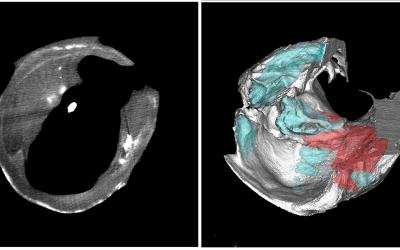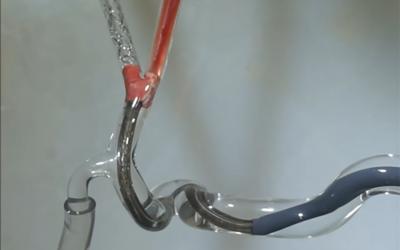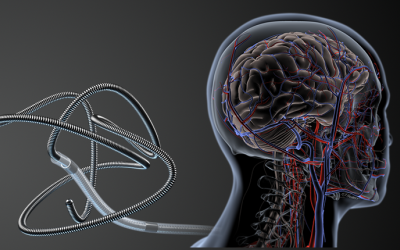
Innovative Testing Platforms
Developing safer and more effective endovascular technologies and techniques requires sophisticated, highly realistic preclinical testing platforms.
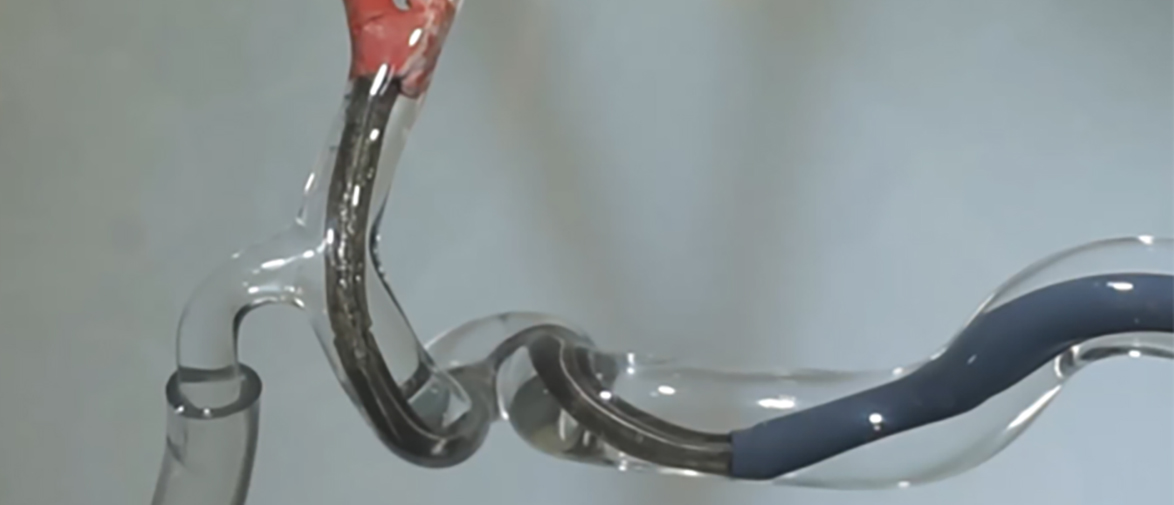
Mechanical thrombectomy testing using glass phantoms and clot analogs developed in-house.
The TNT Lab has developed multiple platforms for testing devices targeting large vessel occlusion stroke, brain aneurysms, embolization of the middle meningeal artery, pulmonary embolism and other vascular lesions. All these platforms leverage extensive in-house experience in additive manufacturing techniques, patient-derived data (including anatomical geometries), precise physiological flow loops, advanced human cadaveric models and large in-vivo animal models.
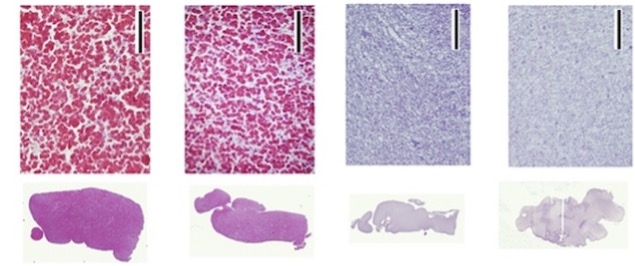
The lab generates and maintains a library of histologically and mechanically validated emboli analogs derived from human blood to match emboli causing large vessel occlusion strokes, pulmonary embolisms, and other thromboembolic events. The TNT Lab also has a library of materials mimicking both soft (for example, vessel wall and muscle) and hard (such as, bone and plaque) biological tissues.
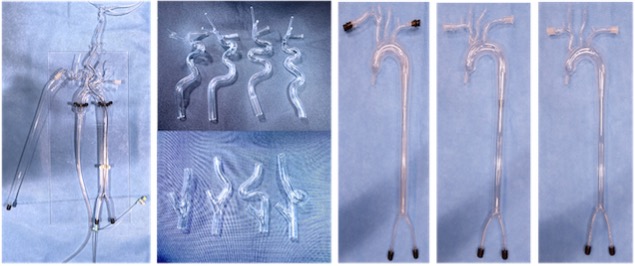
The lab has developed 3D printed and Glass phantoms of different vasculature for embolic occlusion and testing of mechanical thrombectomy. These models are based on patient-derived anatomy, ensuring high anatomical accuracy and precision. A few examples of these are models of the skull base, carotid arteries, superior sagittal sinus, aorta and its various types of arches, pulmonary arteries and many others.
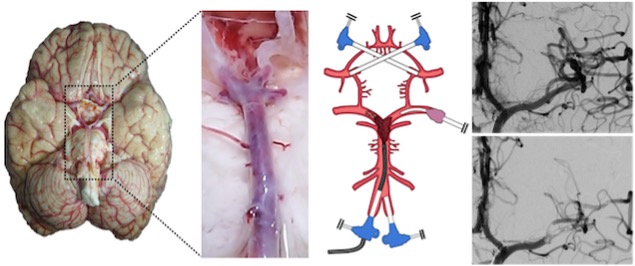
The lab utilizes fresh human brain specimens to create a validated testing model that closely imitates the flow of blood within live brains. This model is ideal for testing of devices for thrombectomy in large and medium vessel occlusion, and treatment of aneurysms.
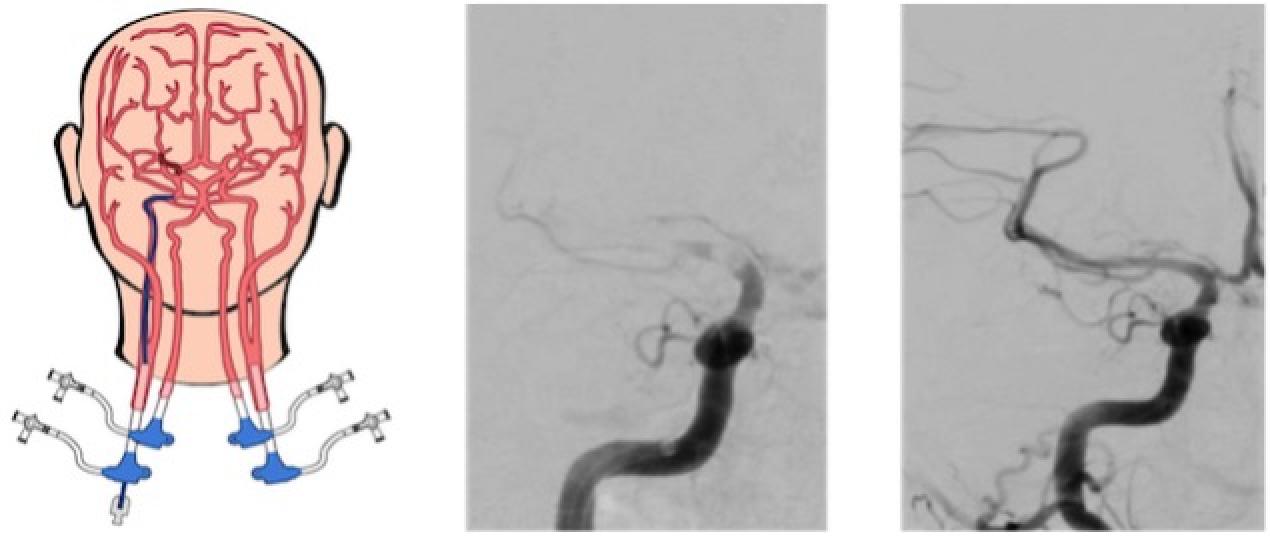
Head and neck cadaveric models are also used to provide further information about device traction and steerability within the human neck. These act as ideal testing platforms to validate new devices for thrombectomy in large and medium vessel occlusion, middle meningeal artery embolization and treatment of aneurysms.
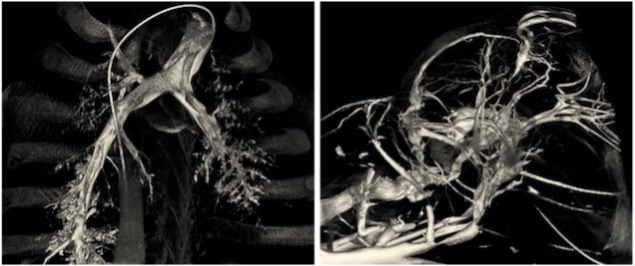
The lab conducts acute as well as chronic experiments using a variety of animals, depending on the anatomical structure being targeted and the type of device being tested. These animals include large animals such as swine and sheep as well as smaller animals such as rabbits. Using the highest standards of animal care, we employ individualized protocols for optimum testing of devices for several vascular pathologies. These include stroke due to large vessel occlusions, aneurysms, pulmonary embolism and various other pathologies.
Liu Y, Abbasi M, Arturo Larco JL, Kadirvel R, Kallmes DF, Brinjikji W, Savastano LE. Preclinical testing platforms for mechanical thrombectomy in stroke: a review on phantoms, in-vivo animal, and cadaveric models. https://jnis.bmj.com/content/early/2021/03/14/neurintsurg-2020-017133 Journal of NeuroInterventional Surgery. 2021; doi:10.1136/neurintsurg-2020-017133.
Liu Y, Gebrezgiabhier D, Reddy A, Davis E, Zheng Y, Arturo Larco JL, Shih AJ, Pandey AS, Savastano LE. Failure modes and effects analysis of mechanical thrombectomy for stroke discovered in human brains. https://thejns.org/view/journals/j-neurosurg/aop/article-10.3171-2020.11.JNS203684/article-10.3171-2020.11.JNS203684.xml Journal of Neurosurgery. 2021; doi:10.3171/2020.11.JNS203684.
Gebrezgiabhier D, Liu Y, Reddy AS, Davis E, Zheng Y, Arturo Larco JL, Shih AJ, Pandey AS, Savastano LE. A human brain test bed for research in large vessel occlusion stroke. https://thejns.org/view/journals/j-neurosurg/aop/article-10.3171-2020.7.JNS202278/article-10.3171-2020.7.JNS202278.xml Journal of Neurosurgery. 2021; doi:10.3171/2020.7.JNS202278.
Liu Y, Reddy A, Cockrum J, Ajulufoh MC, Zheng Y, Shih AS, Pandey AS, Savastano LE. Standardized fabrication method of human-derived emboli with histologic and mechanical quantification for stroke research. https://www.sciencedirect.com/science/article/pii/S1052305720306236?via=ihub Journal of Stroke and Cerebrovascular Diseases. 2020; doi:10.1016/j.jstrokecerebrovasdis.2020.105205.
Reddy A, Liu Y, Cockrum J, Gebrezgiabhier D, Davis E, Zheng Y, Pandey AS, Shih AJ, Savastano LE. Construction of a comprehensive endovascular test bed for research and device development in mechanical thrombectomy in stroke. https://thejns.org/view/journals/j-neurosurg/134/4/article-p1190.xml Journal of Neurosurgery 2021; doi:10.3171/2020.1.JNS192732.
Ding YH, Fitzgerald S, Liu Y, Dai D, Jakaitis D, Doyle KM, Brinjikji W, Kallmes DF, Savastano LE, Kadirvel R. A Novel Rabbit Thromboembolic Occlusion Model. https://jnis.bmj.com/content/early/2021/02/10/neurintsurg-2020-017073 Journal of NeuroInterventional Surgery. 2021; doi:10.1136/neurintsurg-2020-017073.


